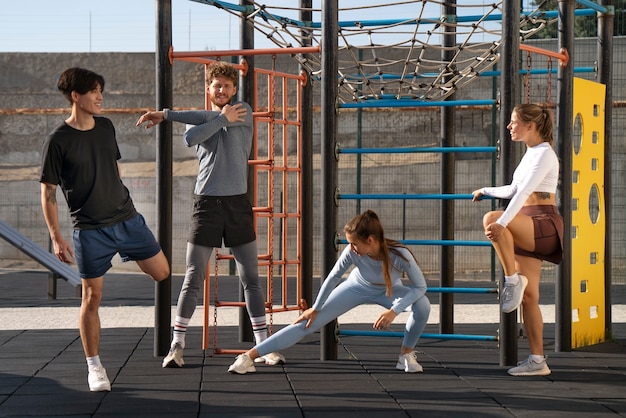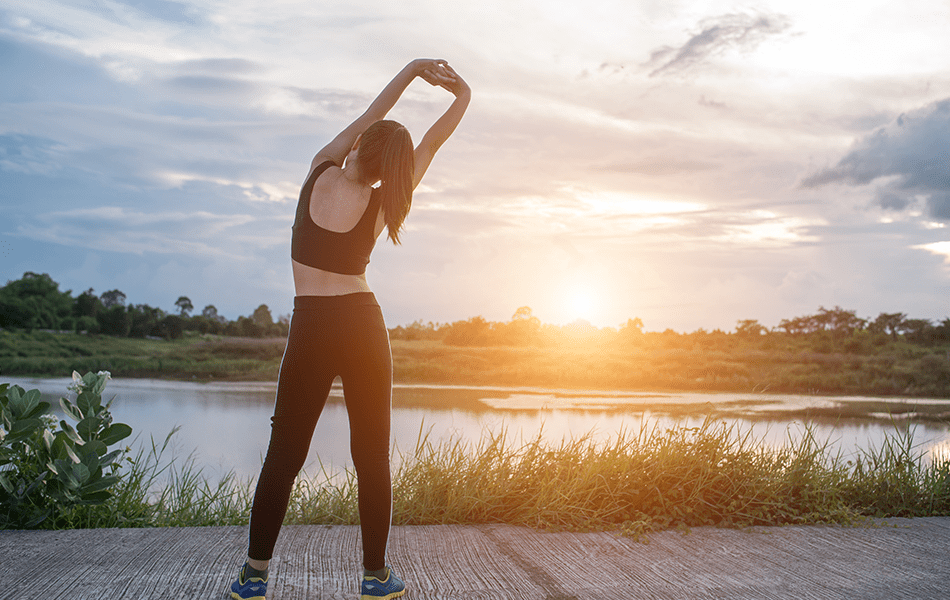Keeping in shape and physically active can be difficult tasks, especially here in the Philippines, where fitness centers are few and far between and where it can be difficult to locate effective workout regimens. But anyone can maintain their physical fitness in this tropical climate if they put in the effort and have the right information. In this article, we will go over some simple and balanced training strategies and simple exercises that you may do to stay healthy and physically active while living in the Philippines.
but first…
Why should you stay active?
Participating in consistent physical activity is one of the most beneficial behaviors that you can adopt for the sake of your health. By engaging in vigorous physical activity, you can improve your brain health, help control your weight, lower your risk of developing disease, strengthen your bones and muscles by doing muscle-strengthening activities, and enhance your ability to do activities of daily living.
Older adults who sit for shorter periods of time and participate in any level of moderately intense to vigorous physical activity reap some health benefits. Physical activity is one of the few lifestyle decisions that can have a significant effect on your overall health.
It does not matter a person’s age, ability, ethnicity, form, or size to become active in order to reap the health benefits of physical activity that it provides.
How can inactivity hurt your health?
It has been demonstrated beyond a reasonable doubt that a lack of physical activity is a risk factor for cardiovascular disease as well as other conditions.
- People who are less physically active and fit have a higher likelihood of acquiring high blood pressure.
- Your chance of developing type 2 diabetes can be lowered by engaging in physical activity.
- Studies have shown that those who engage in regular physical activity have a lower risk of developing coronary heart disease compared to those who lead sedentary lifestyles. Even after taking into consideration factors such as diet, alcohol consumption, and smoking, the researchers came to this conclusion.
- A lack of physical activity has been shown to contribute to feelings of anxiety as well as sadness.
- The chance of developing certain malignancies may be increased by a sedentary lifestyle.
- People who are overweight or obese but also participate in regular physical activity have a much lower chance of developing a variety of diseases.
- Active older persons can minimize their risk of falling and enhance their capacity to carry out day-to-day tasks, both of which are benefits of increased physical activity.
What are 5 ways to be active?

Find some physical activities that you take pleasure in doing and consider how you might work them into your daily routine. Being active does not require that you spend a lot of time at the gym. In order to improve your health and overall well-being, try to reduce the amount of time you spend sitting or lying down each day. By adhering to basic, common-sense precautions and advice while exercising, you can avoid getting hurt and receive health benefits!
1. Begin with the basics.
Gradually increase the amount of activity you are doing. Physically active people start exercising with simple pursuits, such as going for a brisk walk, gardening, or performing basic chores around the house, such as house cleaning. When you first wake up in the morning, when you get lunch, and when you get home from work, go for a quick walk around the neighborhood that lasts ten minutes.
2. Take pleasure in what you’re doing.
Participate in exercise program activities that you, your exercise buddy, and your family member find enjoyable together, such as yoga class, jumping jacks, etc. You can also utilize the links that we’ve provided below to locate alternatives and activities that groups do in your region. These hobbies will eventually become less difficult, more engaging, soothing, and fulfilling as time goes on.
3. Create a strategy, and then stick to it.
Create a set schedule for yourself to follow in order to stay active. Don’t forget that every step counts and that climbing stairs is even better for your fitness than walking!
4. Interact and play with your pets.
When you own a dog, it goes without saying that you have to take them out for regular walks and let them play. Tie a ribbon or rope around your wrist and let it dangle to the floor if you’re a cat person. This will make it look like your cat is having the most amazing time ever just lounging about. Your cat will go absolutely crazy trying to follow you around as you clean your house or complete any other task that requires a lot of walking.
5. Instead of using a shopping cart, you should use a basket.
If you only have a few items to pick up after work, a basket is a better option than a cart. It’s like having a weightlifting session and muscle-strengthening activities without even trying!
Why is staying active important for mental health?
Active people who exercise frequently typically do it for no other reason than the fact that it improves their mood. Your mood, your ability to concentrate, your blood pressure, and your level of awareness can all benefit from exercise. It even has the potential to give you a more optimistic perspective on life.
There is a complex relationship between physical activity and mental well-being. For example, a sedentary lifestyle can play a role in both the development and progression of mental diseases. However, there are other ways in which physical activity can benefit one’s mental health, including the following:
- When you exercise, the levels of certain chemicals in the brain fluctuate. Some of these chemicals include serotonin, stress hormones, and endorphins.
- Exercising on a regular basis can improve your quality of sleep. And healthy sleep helps you manage your emotions.
- Your sense of control, ability to cope, and self-esteem can all benefit from regular exercise. People who exercise on a consistent basis frequently comment on how fantastic it feels when they accomplish a goal.
- Working out can help divert your attention away from unpleasant thoughts and provide opportunities for you to try new things.
- If you workout with other people, it presents an opportunity to socialize and provides a source of social support.
- Your level of energy and health benefits will increase as you exercise.
- Your tensions could be alleviated by engaging in some physical activity.
- The tension in your skeletal muscles can be reduced by exercise, which in turn can help you feel more relaxed.
People who suffer from mental illness can also benefit significantly from the physical improvements brought on by exercise. Your cardiovascular health and your overall physical health will both improve as a result of this. This is significant because people who struggle with mental health disorders are at greater risk of developing chronic physical conditions including asthma, arthritis, diabetes, and heart disease.
However, exercising regularly and participating in and staying active in other forms of physical activity have been demonstrated to help boost energy levels and improve mood. It is possible that it is related to many additional significant health benefits, one of which is a decreased risk of developing a chronic condition.
The term “exercise” refers to any physical activity that compels your muscle tone to contract and forces your body to use up more calories in the process. There are many different kinds of physical activities, some examples of which are dancing, walking, running, jogging, and muscle-strengthening activities. Swimming is another popular choice. Research has proven that being active has many positive effects on one’s health, both physically and emotionally. Staying active could possibly make your life a little bit longer, and you should always stay motivated.
The following are the top ten ways that your body and brain benefit from regular physical activity:
10 importance of physical activity
1. Exercise can improve your mood.
Exercise can help boost your mood and reduce feelings of despair, worry, and stress, according to a number of studies. It causes alterations in the regions of the brain that are responsible for regulating anxiety and stress. Additionally, it has the potential to boost the brain’s sensitivity to the neurotransmitters serotonin and norepinephrine, both of which work to alleviate the symptoms of depression.
Endorphins are known to promote happy feelings and lower the impression of pain. Exercise can help enhance the production of endorphins, which can help lessen the experience of pain. It is interesting to note that the intensity of your workout does not make a difference. It would appear that the benefits of exercise on mood are unrelated to the level of intensity of the physical activity.
2. Physical activity can help you lose weight.
Inactivity is one of the primary contributors to weight gain and obesity. It is essential to have a firm grasp on the connection that exists between physical activity and the amount of energy that is used up throughout the course of the activity in order to comprehend the impact that exercise has on the process of weight loss.
There are three ways in which your body uses up its energy:
- Digesting food
- Through exercise,
- You can ensure that your body’s processes, such as your heartbeat and breathing, continue uninterrupted.
If you limit the number of calories you consume while dieting, your metabolic rate will decrease, which may momentarily slow down your weight loss. On the other hand, it has been demonstrated that engaging in regular physical activity guidelines can boost your metabolic rate, leading to an increase in the number of calories burned during the day. The combination of aerobic exercise, healthy eating, and resistance training can maximize fat loss and muscle mass maintenance, which is critical for preserving lean muscle mass and preventing weight gain.
3. Physical activity is beneficial to both your muscles and your bones.
Exercising regularly and staying active are absolutely necessary for developing and preserving strong muscles and bones. Muscle strengthening exercises such as weightlifting, push-ups, lifting weights, and other resistance exercises, when combined with a sufficient consumption of protein, can help increase and improve muscle strength and growth.
This is because exercise helps produce hormones that enhance your muscles’ ability to absorb amino acids, and exercise is one of the best ways to achieve this. This helps them grow and minimizes the likelihood of them breaking down.
People have a tendency to lose both muscle mass and function as they age, which might put them at a higher risk of suffering an accident. Regular exercise is absolutely necessary if you want to slow down the process of muscle atrophy and keep your strength as you get older. In addition to assisting in the prevention of osteoporosis in later years, exercise is beneficial for increasing bone density when a person is still young.
4. Exercise boosts energy.
Many people, especially those with medical issues, find exercise energizing. Intensity aerobic exercise enhances energy by strengthening the heart and lungs and reducing the risk of a heart attack.
As you move, your heart pumps more blood, oxygenating your working muscles. Regular exercise improves your heart’s oxygen delivery to your muscles. Intensity aerobic training reduces lung demand and energy use, making you less likely to get out of breath during intensive activity.
5. Exercise can improve skin health.
Oxidative stress can have negative effects on your skin.
When the body’s antioxidant defenses are unable to fully repair the cell damage caused by molecules known as free radicals, this is known as oxidative stress. This might disrupt the skin’s cellular structure and cause problems.
While strenuous exercise can increase the risk of cell death due to oxidative stress, moderate exercise has been shown to boost your body’s production of natural antioxidants.
Similarly, exercise has been shown to improve blood flow and create cell changes that slow the visible signs of skin aging.
6. Exercise improves brain health and memory.
Exercise boosts brain function and memory. First, it raises your heart rate, which boosts brain oxygenation. It also boosts brain cell growth hormones.
Exercise also prevents chronic diseases, which can impair brain function. Since aging, oxidative stress, and inflammation cause brain alterations, older people should exercise regularly. Finally, exercise reduces brain alterations that can cause health conditions such as Alzheimer’s disease and dementia.
7. Relaxation and better sleep are two of the many benefits of exercise.
Better sleep and relaxation are two side effects of a regular exercise routine. Exercise-induced energy depletion (loss) improves sleep quality by triggering restorative mechanisms. In addition, the rise in core body temperature associated with exercise has been linked to better sleep by facilitating a more rapid decrease in temperature during slumber.
Better sleep and more energy during the day are both benefits of regular physical activity, whether it be aerobic or a combination of aerobic and resistance training.
8. Exercise can help ease pain.
Exercising, despite the fact that chronic pain can be incapacitating at times, can really help alleviate the discomfort. In fact, for many years, the advice given to cure chronic disease pain was to be inactive and to get plenty of rest. In addition, physical activity can both increase a person’s pain tolerance and diminish their ability to feel pain.
Exercise has beneficial effects on the pain that might be connected with a variety of diseases. It has also been shown to boost one’s tolerance to pain.
9. Improves respiratory health
Whether you have healthy lungs or are dealing with a lung condition, even 30 minutes of moderate exercise five days a week can help. You may be winded, but regular exercise will strengthen your cardiovascular system, strengthen your muscles, and improve your endurance.
10. Improves Self-Esteem
Physical activity and exercise boost self-confidence, self-esteem, and self-worth in people of all ages, from 7 to 70. It’s great for your mood and energy levels, and it does wonders for your body. Depression, stress, excess body weight, and health problems are key contributors to low self-worth and confidence, all of which can be ameliorated via regular exercise.,
To sum it all up, physical and psychological well-being benefit from regular exercise and movement. Increased physical activity has been shown to have positive effects on a wide range of health indicators, including heart and gut function, chronic conditions, sleep, blood sugar regulation, cognitive function, mood, and quality of life. In addition to these benefits, it has also been shown to decrease the likelihood of experiencing a stroke or developing several forms of cancer and heart disease.
Doing exercises that target diverse aspects of fitness, such as stamina, strength, mobility, and equilibrium, on a consistent basis is ideal. Some types, however, may be more crucial than others at various points throughout one’s life and in pursuit of various objectives. Be sure to ease into it at a pace that’s comfortable for you. Staying healthy requires regular exercise and a diet rich in nutrients.
Asterra condominium, a home for a healthy lifestyle;
When looking for a home, it is crucial to look for one that promotes a healthy lifestyle rather than just any ordinary house. Fortunately, Asterra provides an affordable condo that can improve your everyday routine with its top-notch amenities.
Amenities such as a play area and a basketball court where you can channel your inner athlete while also improving your agility and endurance. A pool where you may improve your coordination, balance, and posture. And finally, a gym where you can develop your muscle strength and endurance. Exercise helps your cardiovascular system perform more efficiently by delivering oxygen and nutrients to your tissues. And when your heart and lung health improve, you will have more energy to complete daily tasks. Inquire now to know more about Asterra!
Written by: Keanu Sasis





